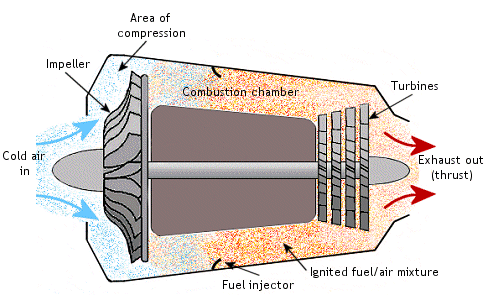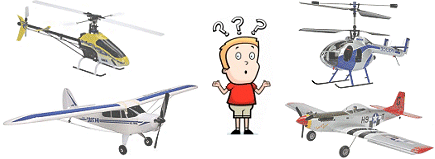The model jet engine (gas turbine)
A true rc
model jet engine (turbine) adds the ultimate touch of realism to an rc jet, and commercially produced units for radio control use are now widely available and becoming more commonplace.
Turbine rc jet flying has become a big thing in recent years and there are some spectacular models around, but this aspect of the hobby is
not for the novice! Endless hours of flying experience and an impressive budget are needed to actively participate in flying radio control jets with real gas turbines. Even the smaller model jet engines can cost upwards of a thousand dollars - and that's on top of the cost of the jet itself, radio gear and all the other bits needed. So it's serious business indeed but ultimately has to be one of the most rewarding ways of enjoying rc flying...
if you can afford it!
Incidentally, rc model gas turbines are also used in larger scale helicopters but, from a personal point of view, I don't find these too realistic because of the sound - rc helicopters running on a turbine sound more like jets than helicopters (
again, just a personal opinion!).

Shown right is a
JetCat model turbine, one of the more popular commercially produced model jet engines readily available.
JetCat USA are at the forefront of this remarkable technology and offer some excellent turbine units.
Before model jet engines appeared on the radio control flying scene, rc jets always lacked the authenticity of having a true gas turbine; previously radio control jets had to be powered by either gas or electric motors with a propeller (thus spoiling the look of the aircraft) or noisy IC ducted fan units. Pulse jets were another option but these are more rocket motors than anything else, a pulse jet runs at full throttle for a short time and then the jet glides.
But now model jets can be powered by a fully functional and realistic looking and sounding jet turbine, thanks to manufacturers like JetCat!
How model jet engines work
A model jet engine design can vary slightly from one manufacturer to another but they all work on the same basic principle. The most common type nowadays is the
centrifugal flow turbine as opposed to the lengthier axial flow turbine.
The big difference between centrifugal and axial flow turbines is in the stage of compression. In a centrifugal flow unit, air entering the turbine is thrown
outwards as it passes over the spinning
impeller, or
compressor. The air hits against the inside of the can and so is compressed greatly before passing into the combustion chamber. This intense compression increases the pressure and hence temperature of the air, making it more effective when it mixes with the fuel.
The kerosene based fuel, commonly called '
Jet A1', is introduced into the combustion chamber as a very fine mist and so mixes easily with the now highly compressed air. This fuel/air mixture is then ignited by a small glow plug, much the same as the one found on a 2 or 4 stroke
model airplane engine.
As the fuel/air mixture ignites and explodes within the chamber the coned shape of the chamber and the incoming flow of new air forces the mixture rearwards towards the turbine; the rapid flow of the fuel/air mixture spins the turbine which in turn spins the compressor at the front of the jet engine (the turbine and compressor are connected by a central shaft).
The gases (exhaust) finally get squeezed through the narrowing jet pipe at the very rear of the engine, exiting at great speed and pressure thus generating the high levels of thrust.
The drawing below shows the basic principle of a centrifugal flow model jet engine:

Model jet engines need to be started with compressed air to initially power-up the turbine. This can be supplied from a diver's oxygen tank or a similar source. Only when the compressor has reached the necessary revolutions per minute (RPM) can the fuel be introduced into the chamber and the engine operate normally.
 Shown right is a JetCat model turbine, one of the more popular commercially produced model jet engines readily available.
Shown right is a JetCat model turbine, one of the more popular commercially produced model jet engines readily available. 









